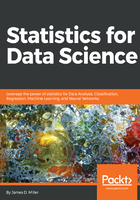
Neural networks
Neural networks are also called artificial neural networks (ANNs), and the objective is to solve problems in the same way that the human brain would.
Google will provide the following explanation of ANN as stated in Neural Network Primer: Part I, by Maureen Caudill, AI Expert, Feb. 1989:
To oversimplify the idea of neural networks, recall the concept of software encapsulation, and consider a computer program with an input layer, a processing layer, and an output layer. With this thought in mind, understand that neural networks are also organized in a network of these layers, usually with more than a single processing layer.
Patterns are presented to the network by way of the input layer, which then communicates to one (or more) of the processing layers (where the actual processing is done). The processing layers then link to an output layer where the result is presented.
Most neural networks will also contain some form of learning rule that modifies the weights of the connections (in other words, the network learns which processing nodes perform better and gives them a heavier weight) per the input patterns that it is presented with. In this way (in a sense), neural networks learn by example as a child learns to recognize a cat from being exposed to examples of cats.